Therapeutic Use of Self: Assessment Report, Semester 1, 2019
VerifiedAdded on 2023/04/22
|10
|2484
|381
Report
AI Summary
This report analyzes the therapeutic use of self in nursing, focusing on the impact of stigma and biases on mental healthcare, and strategies to overcome them for empathetic, patient-centered care. It delves into the interplay of personal and professional values in the workplace, emphasizing empathy and responsibility. The report highlights the importance of maintaining personal integrity and pliancy through intra and interaction with people in healthcare practice, especially considering the health equity among Aboriginals and people living in rural areas. The author reflects on personal experiences, acknowledging the challenges of the nursing profession and emphasizing the need for multidisciplinary approaches to improve patient care and overall community health, particularly in regions with limited healthcare access. The report underscores the significance of acknowledging and addressing stigma and biases to promote equitable health treatments and enhance the patient-centered orientation of nursing practice.
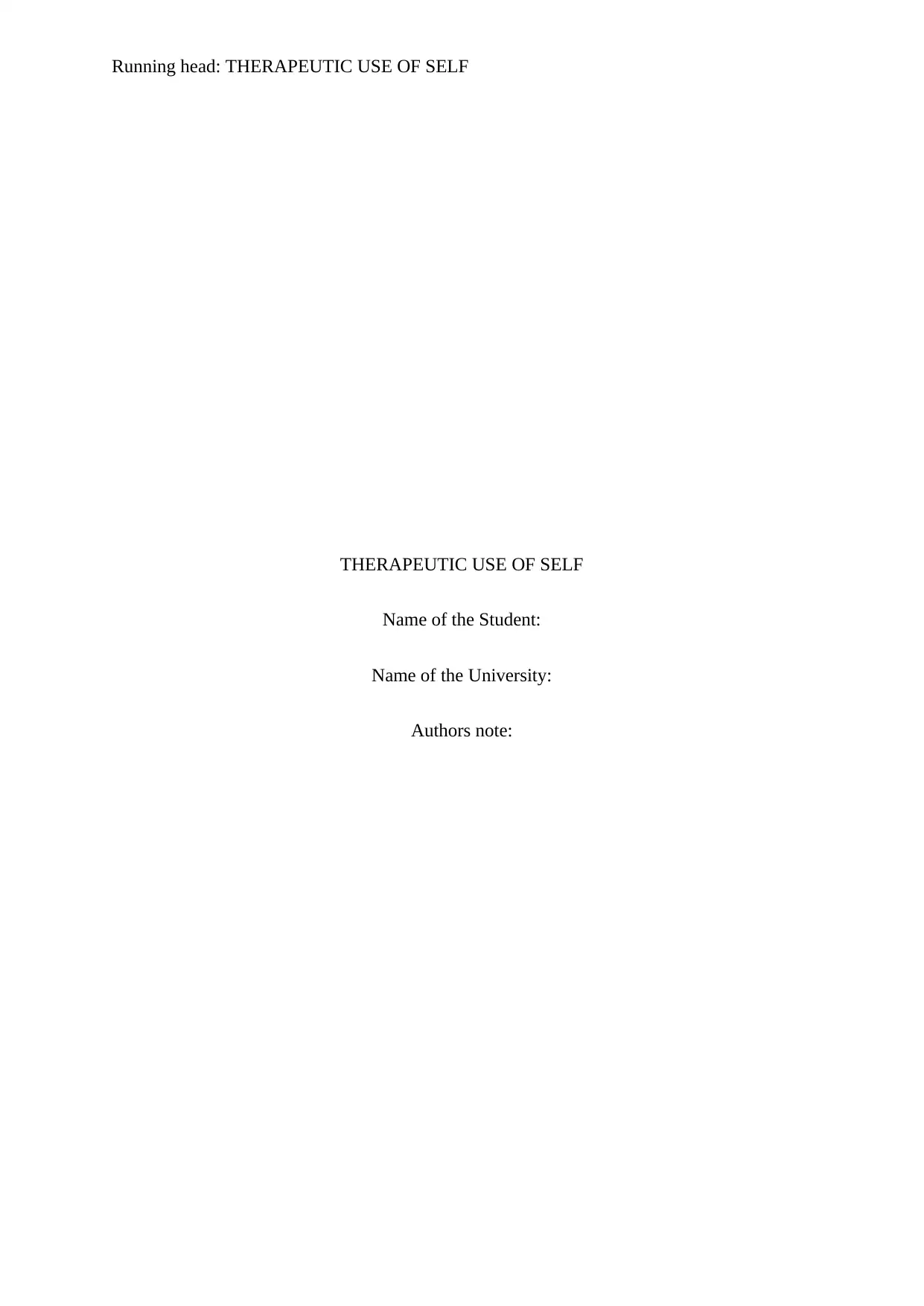
Running head: THERAPEUTIC USE OF SELF
THERAPEUTIC USE OF SELF
Name of the Student:
Name of the University:
Authors note:
THERAPEUTIC USE OF SELF
Name of the Student:
Name of the University:
Authors note:
Paraphrase This Document
Need a fresh take? Get an instant paraphrase of this document with our AI Paraphraser
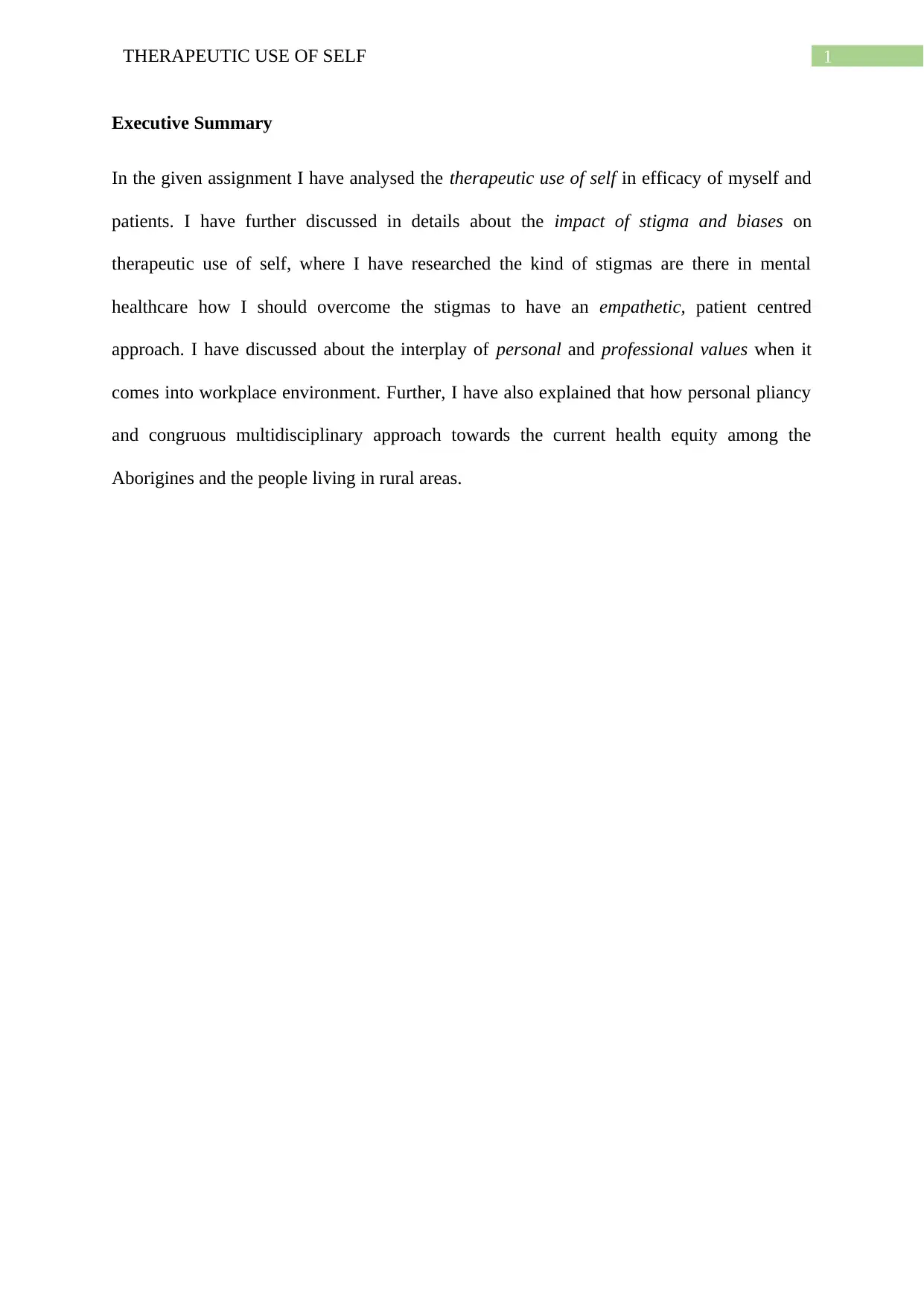
1THERAPEUTIC USE OF SELF
Executive Summary
In the given assignment I have analysed the therapeutic use of self in efficacy of myself and
patients. I have further discussed in details about the impact of stigma and biases on
therapeutic use of self, where I have researched the kind of stigmas are there in mental
healthcare how I should overcome the stigmas to have an empathetic, patient centred
approach. I have discussed about the interplay of personal and professional values when it
comes into workplace environment. Further, I have also explained that how personal pliancy
and congruous multidisciplinary approach towards the current health equity among the
Aborigines and the people living in rural areas.
Executive Summary
In the given assignment I have analysed the therapeutic use of self in efficacy of myself and
patients. I have further discussed in details about the impact of stigma and biases on
therapeutic use of self, where I have researched the kind of stigmas are there in mental
healthcare how I should overcome the stigmas to have an empathetic, patient centred
approach. I have discussed about the interplay of personal and professional values when it
comes into workplace environment. Further, I have also explained that how personal pliancy
and congruous multidisciplinary approach towards the current health equity among the
Aborigines and the people living in rural areas.
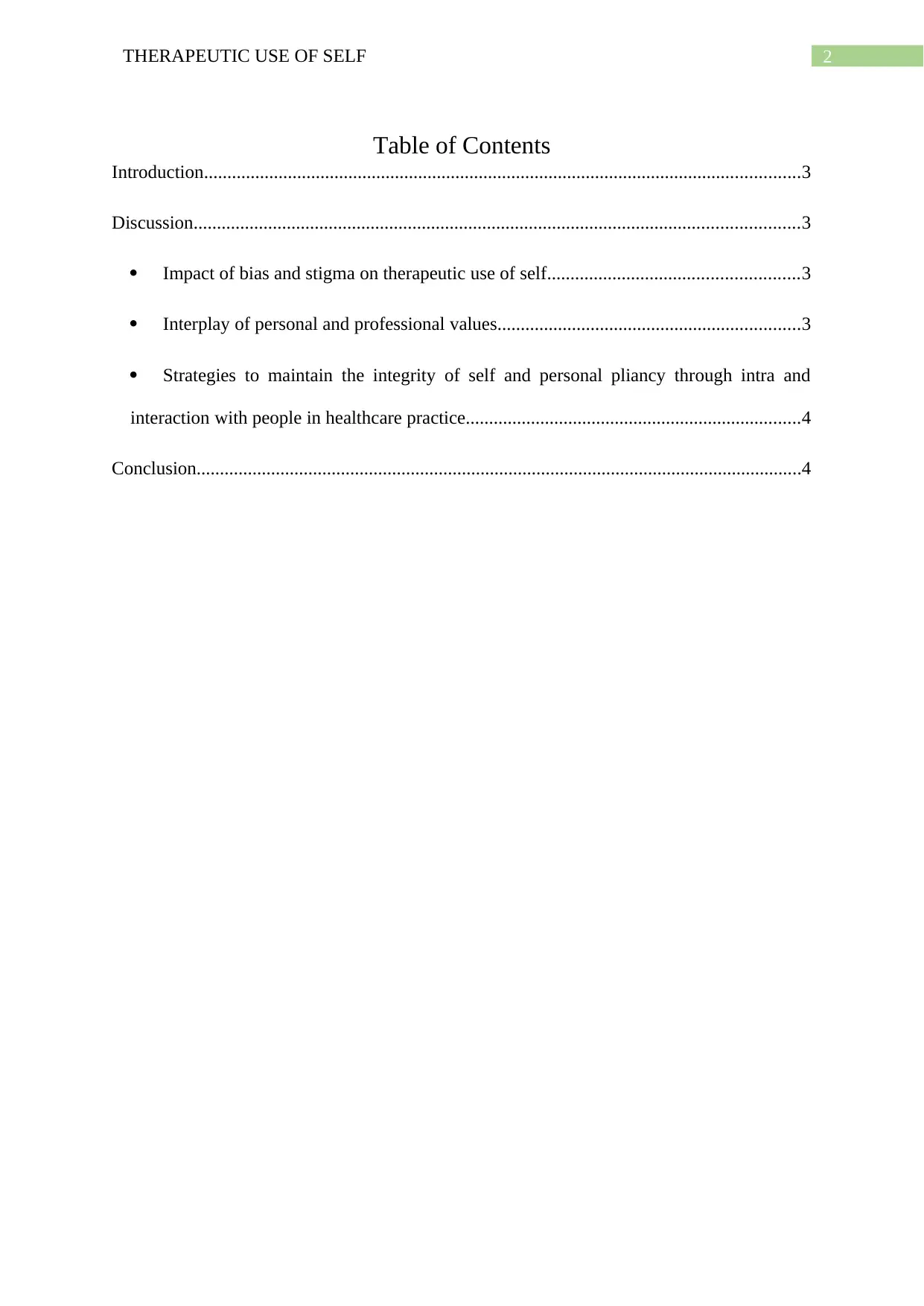
2THERAPEUTIC USE OF SELF
Table of Contents
Introduction................................................................................................................................3
Discussion..................................................................................................................................3
Impact of bias and stigma on therapeutic use of self......................................................3
Interplay of personal and professional values.................................................................3
Strategies to maintain the integrity of self and personal pliancy through intra and
interaction with people in healthcare practice........................................................................4
Conclusion..................................................................................................................................4
Table of Contents
Introduction................................................................................................................................3
Discussion..................................................................................................................................3
Impact of bias and stigma on therapeutic use of self......................................................3
Interplay of personal and professional values.................................................................3
Strategies to maintain the integrity of self and personal pliancy through intra and
interaction with people in healthcare practice........................................................................4
Conclusion..................................................................................................................................4
⊘ This is a preview!⊘
Do you want full access?
Subscribe today to unlock all pages.

Trusted by 1+ million students worldwide
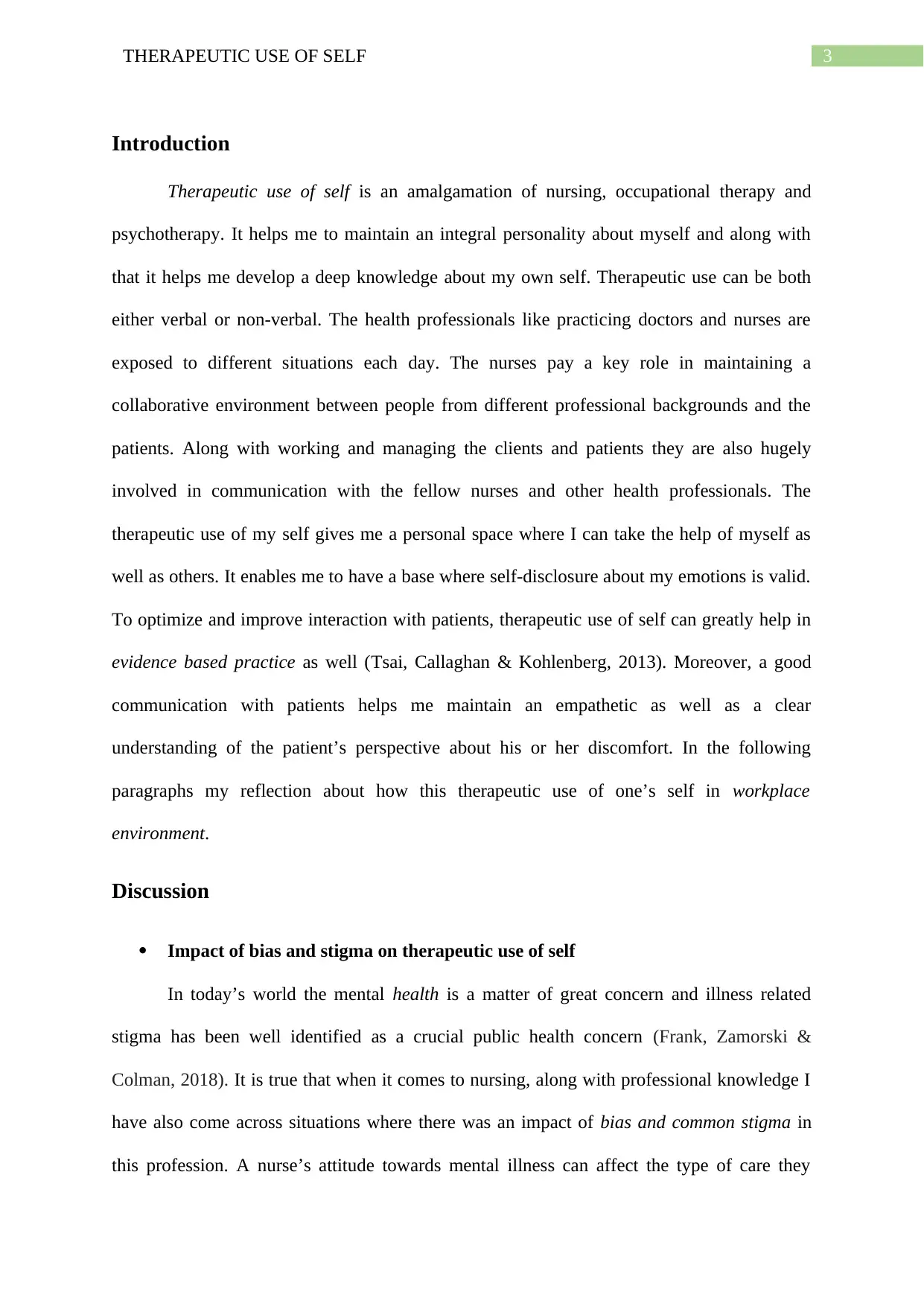
3THERAPEUTIC USE OF SELF
Introduction
Therapeutic use of self is an amalgamation of nursing, occupational therapy and
psychotherapy. It helps me to maintain an integral personality about myself and along with
that it helps me develop a deep knowledge about my own self. Therapeutic use can be both
either verbal or non-verbal. The health professionals like practicing doctors and nurses are
exposed to different situations each day. The nurses pay a key role in maintaining a
collaborative environment between people from different professional backgrounds and the
patients. Along with working and managing the clients and patients they are also hugely
involved in communication with the fellow nurses and other health professionals. The
therapeutic use of my self gives me a personal space where I can take the help of myself as
well as others. It enables me to have a base where self-disclosure about my emotions is valid.
To optimize and improve interaction with patients, therapeutic use of self can greatly help in
evidence based practice as well (Tsai, Callaghan & Kohlenberg, 2013). Moreover, a good
communication with patients helps me maintain an empathetic as well as a clear
understanding of the patient’s perspective about his or her discomfort. In the following
paragraphs my reflection about how this therapeutic use of one’s self in workplace
environment.
Discussion
Impact of bias and stigma on therapeutic use of self
In today’s world the mental health is a matter of great concern and illness related
stigma has been well identified as a crucial public health concern (Frank, Zamorski &
Colman, 2018). It is true that when it comes to nursing, along with professional knowledge I
have also come across situations where there was an impact of bias and common stigma in
this profession. A nurse’s attitude towards mental illness can affect the type of care they
Introduction
Therapeutic use of self is an amalgamation of nursing, occupational therapy and
psychotherapy. It helps me to maintain an integral personality about myself and along with
that it helps me develop a deep knowledge about my own self. Therapeutic use can be both
either verbal or non-verbal. The health professionals like practicing doctors and nurses are
exposed to different situations each day. The nurses pay a key role in maintaining a
collaborative environment between people from different professional backgrounds and the
patients. Along with working and managing the clients and patients they are also hugely
involved in communication with the fellow nurses and other health professionals. The
therapeutic use of my self gives me a personal space where I can take the help of myself as
well as others. It enables me to have a base where self-disclosure about my emotions is valid.
To optimize and improve interaction with patients, therapeutic use of self can greatly help in
evidence based practice as well (Tsai, Callaghan & Kohlenberg, 2013). Moreover, a good
communication with patients helps me maintain an empathetic as well as a clear
understanding of the patient’s perspective about his or her discomfort. In the following
paragraphs my reflection about how this therapeutic use of one’s self in workplace
environment.
Discussion
Impact of bias and stigma on therapeutic use of self
In today’s world the mental health is a matter of great concern and illness related
stigma has been well identified as a crucial public health concern (Frank, Zamorski &
Colman, 2018). It is true that when it comes to nursing, along with professional knowledge I
have also come across situations where there was an impact of bias and common stigma in
this profession. A nurse’s attitude towards mental illness can affect the type of care they
Paraphrase This Document
Need a fresh take? Get an instant paraphrase of this document with our AI Paraphraser
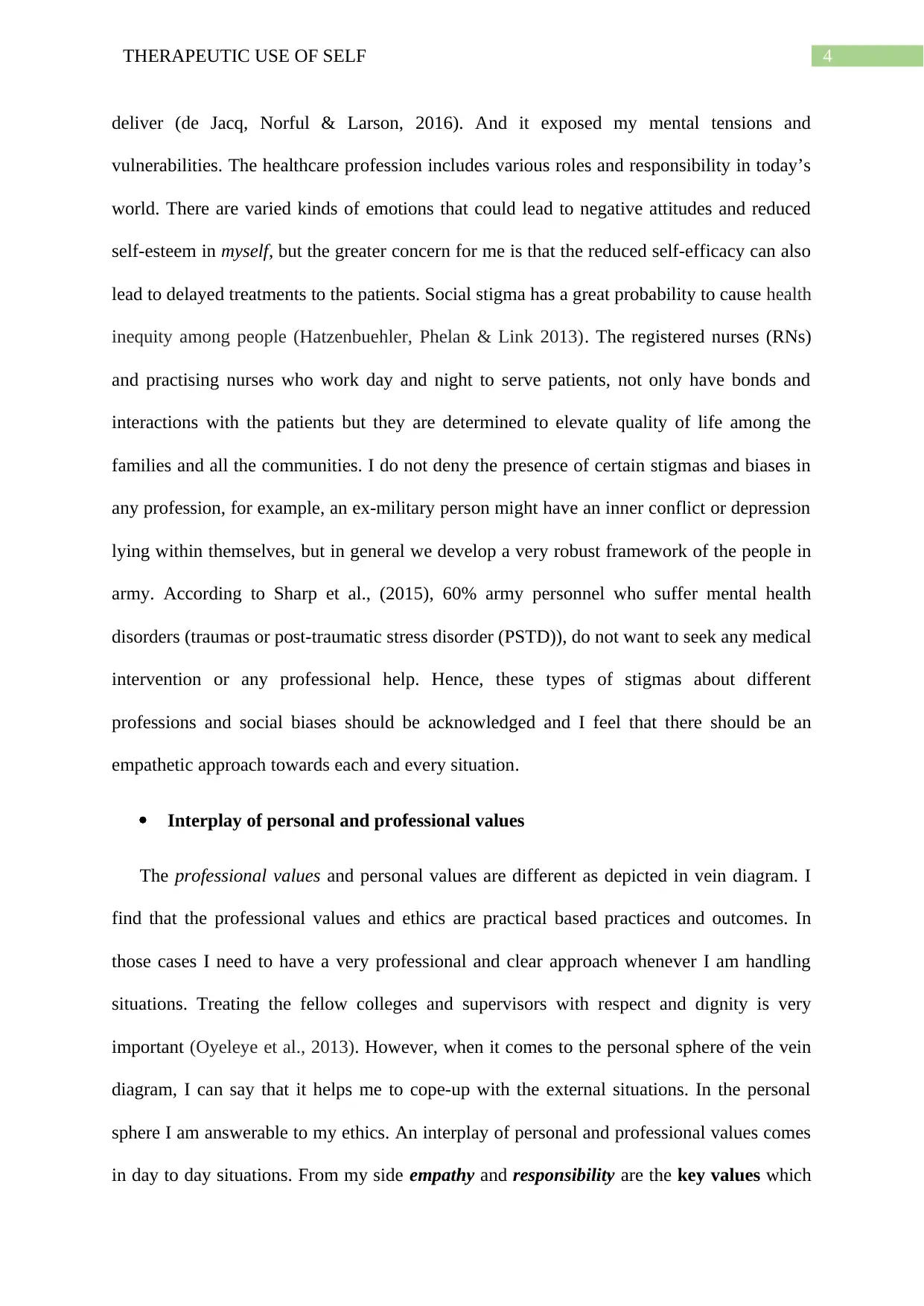
4THERAPEUTIC USE OF SELF
deliver (de Jacq, Norful & Larson, 2016). And it exposed my mental tensions and
vulnerabilities. The healthcare profession includes various roles and responsibility in today’s
world. There are varied kinds of emotions that could lead to negative attitudes and reduced
self-esteem in myself, but the greater concern for me is that the reduced self-efficacy can also
lead to delayed treatments to the patients. Social stigma has a great probability to cause health
inequity among people (Hatzenbuehler, Phelan & Link 2013). The registered nurses (RNs)
and practising nurses who work day and night to serve patients, not only have bonds and
interactions with the patients but they are determined to elevate quality of life among the
families and all the communities. I do not deny the presence of certain stigmas and biases in
any profession, for example, an ex-military person might have an inner conflict or depression
lying within themselves, but in general we develop a very robust framework of the people in
army. According to Sharp et al., (2015), 60% army personnel who suffer mental health
disorders (traumas or post-traumatic stress disorder (PSTD)), do not want to seek any medical
intervention or any professional help. Hence, these types of stigmas about different
professions and social biases should be acknowledged and I feel that there should be an
empathetic approach towards each and every situation.
Interplay of personal and professional values
The professional values and personal values are different as depicted in vein diagram. I
find that the professional values and ethics are practical based practices and outcomes. In
those cases I need to have a very professional and clear approach whenever I am handling
situations. Treating the fellow colleges and supervisors with respect and dignity is very
important (Oyeleye et al., 2013). However, when it comes to the personal sphere of the vein
diagram, I can say that it helps me to cope-up with the external situations. In the personal
sphere I am answerable to my ethics. An interplay of personal and professional values comes
in day to day situations. From my side empathy and responsibility are the key values which
deliver (de Jacq, Norful & Larson, 2016). And it exposed my mental tensions and
vulnerabilities. The healthcare profession includes various roles and responsibility in today’s
world. There are varied kinds of emotions that could lead to negative attitudes and reduced
self-esteem in myself, but the greater concern for me is that the reduced self-efficacy can also
lead to delayed treatments to the patients. Social stigma has a great probability to cause health
inequity among people (Hatzenbuehler, Phelan & Link 2013). The registered nurses (RNs)
and practising nurses who work day and night to serve patients, not only have bonds and
interactions with the patients but they are determined to elevate quality of life among the
families and all the communities. I do not deny the presence of certain stigmas and biases in
any profession, for example, an ex-military person might have an inner conflict or depression
lying within themselves, but in general we develop a very robust framework of the people in
army. According to Sharp et al., (2015), 60% army personnel who suffer mental health
disorders (traumas or post-traumatic stress disorder (PSTD)), do not want to seek any medical
intervention or any professional help. Hence, these types of stigmas about different
professions and social biases should be acknowledged and I feel that there should be an
empathetic approach towards each and every situation.
Interplay of personal and professional values
The professional values and personal values are different as depicted in vein diagram. I
find that the professional values and ethics are practical based practices and outcomes. In
those cases I need to have a very professional and clear approach whenever I am handling
situations. Treating the fellow colleges and supervisors with respect and dignity is very
important (Oyeleye et al., 2013). However, when it comes to the personal sphere of the vein
diagram, I can say that it helps me to cope-up with the external situations. In the personal
sphere I am answerable to my ethics. An interplay of personal and professional values comes
in day to day situations. From my side empathy and responsibility are the key values which
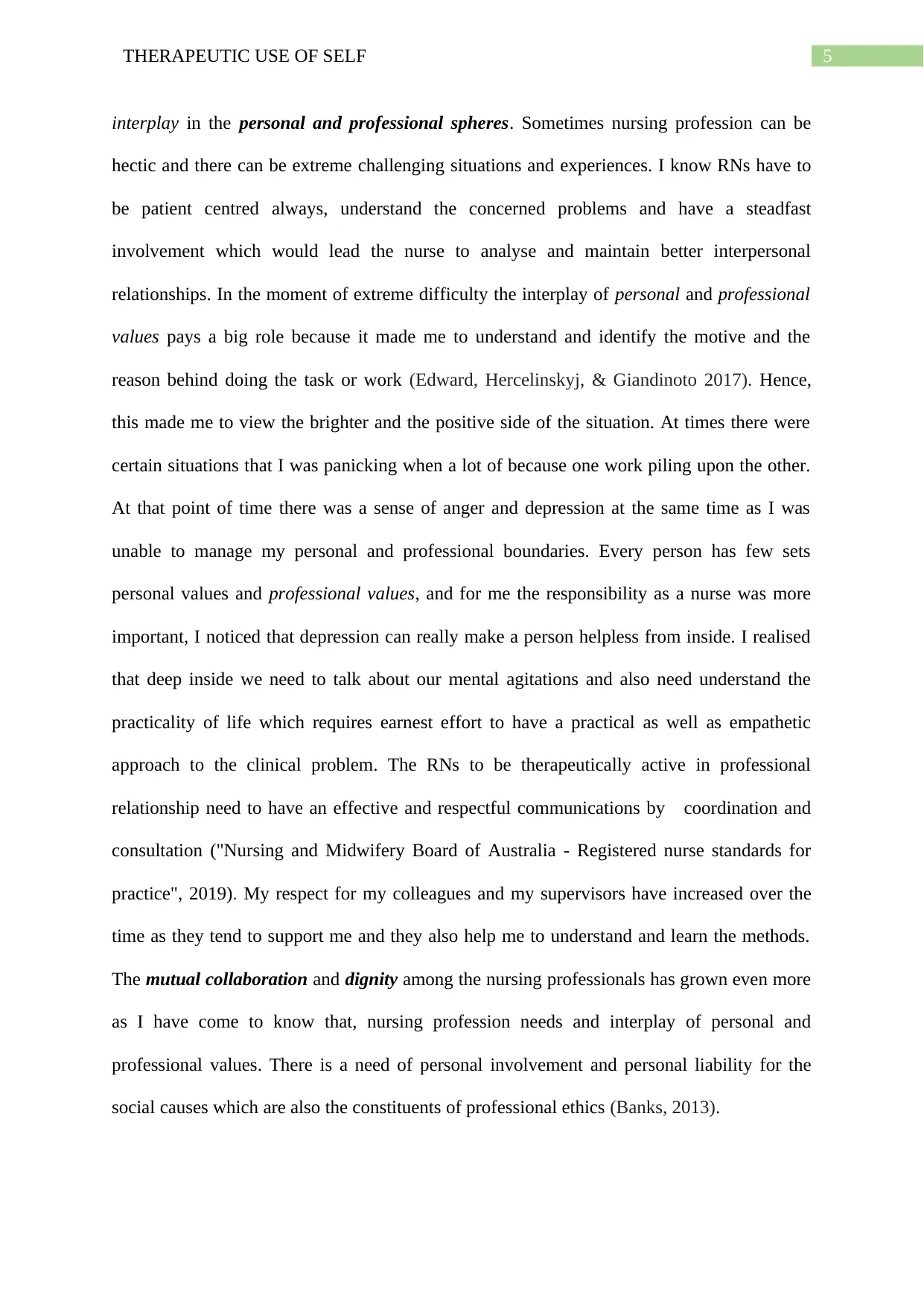
5THERAPEUTIC USE OF SELF
interplay in the personal and professional spheres. Sometimes nursing profession can be
hectic and there can be extreme challenging situations and experiences. I know RNs have to
be patient centred always, understand the concerned problems and have a steadfast
involvement which would lead the nurse to analyse and maintain better interpersonal
relationships. In the moment of extreme difficulty the interplay of personal and professional
values pays a big role because it made me to understand and identify the motive and the
reason behind doing the task or work (Edward, Hercelinskyj, & Giandinoto 2017). Hence,
this made me to view the brighter and the positive side of the situation. At times there were
certain situations that I was panicking when a lot of because one work piling upon the other.
At that point of time there was a sense of anger and depression at the same time as I was
unable to manage my personal and professional boundaries. Every person has few sets
personal values and professional values, and for me the responsibility as a nurse was more
important, I noticed that depression can really make a person helpless from inside. I realised
that deep inside we need to talk about our mental agitations and also need understand the
practicality of life which requires earnest effort to have a practical as well as empathetic
approach to the clinical problem. The RNs to be therapeutically active in professional
relationship need to have an effective and respectful communications by coordination and
consultation ("Nursing and Midwifery Board of Australia - Registered nurse standards for
practice", 2019). My respect for my colleagues and my supervisors have increased over the
time as they tend to support me and they also help me to understand and learn the methods.
The mutual collaboration and dignity among the nursing professionals has grown even more
as I have come to know that, nursing profession needs and interplay of personal and
professional values. There is a need of personal involvement and personal liability for the
social causes which are also the constituents of professional ethics (Banks, 2013).
interplay in the personal and professional spheres. Sometimes nursing profession can be
hectic and there can be extreme challenging situations and experiences. I know RNs have to
be patient centred always, understand the concerned problems and have a steadfast
involvement which would lead the nurse to analyse and maintain better interpersonal
relationships. In the moment of extreme difficulty the interplay of personal and professional
values pays a big role because it made me to understand and identify the motive and the
reason behind doing the task or work (Edward, Hercelinskyj, & Giandinoto 2017). Hence,
this made me to view the brighter and the positive side of the situation. At times there were
certain situations that I was panicking when a lot of because one work piling upon the other.
At that point of time there was a sense of anger and depression at the same time as I was
unable to manage my personal and professional boundaries. Every person has few sets
personal values and professional values, and for me the responsibility as a nurse was more
important, I noticed that depression can really make a person helpless from inside. I realised
that deep inside we need to talk about our mental agitations and also need understand the
practicality of life which requires earnest effort to have a practical as well as empathetic
approach to the clinical problem. The RNs to be therapeutically active in professional
relationship need to have an effective and respectful communications by coordination and
consultation ("Nursing and Midwifery Board of Australia - Registered nurse standards for
practice", 2019). My respect for my colleagues and my supervisors have increased over the
time as they tend to support me and they also help me to understand and learn the methods.
The mutual collaboration and dignity among the nursing professionals has grown even more
as I have come to know that, nursing profession needs and interplay of personal and
professional values. There is a need of personal involvement and personal liability for the
social causes which are also the constituents of professional ethics (Banks, 2013).
⊘ This is a preview!⊘
Do you want full access?
Subscribe today to unlock all pages.

Trusted by 1+ million students worldwide
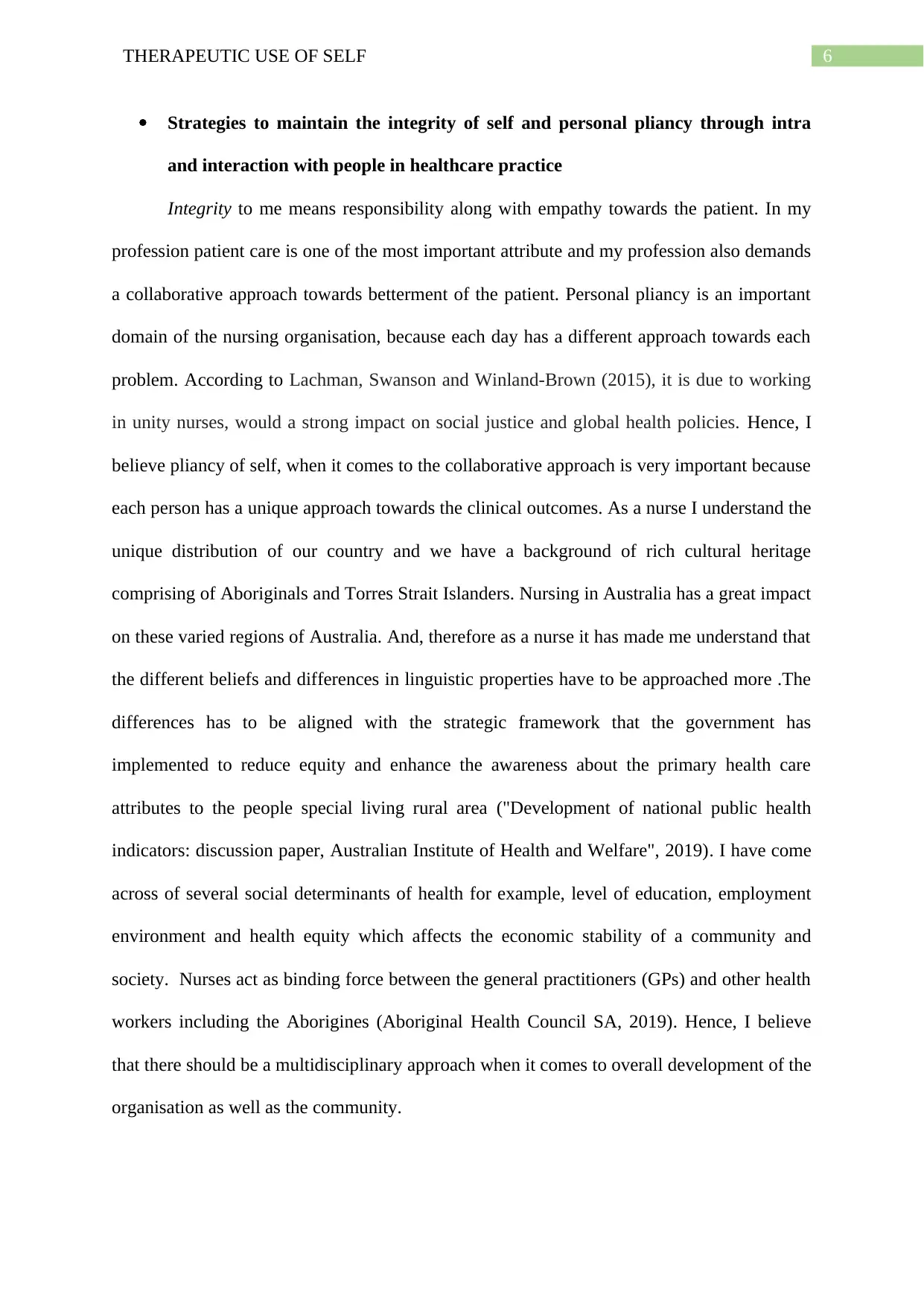
6THERAPEUTIC USE OF SELF
Strategies to maintain the integrity of self and personal pliancy through intra
and interaction with people in healthcare practice
Integrity to me means responsibility along with empathy towards the patient. In my
profession patient care is one of the most important attribute and my profession also demands
a collaborative approach towards betterment of the patient. Personal pliancy is an important
domain of the nursing organisation, because each day has a different approach towards each
problem. According to Lachman, Swanson and Winland-Brown (2015), it is due to working
in unity nurses, would a strong impact on social justice and global health policies. Hence, I
believe pliancy of self, when it comes to the collaborative approach is very important because
each person has a unique approach towards the clinical outcomes. As a nurse I understand the
unique distribution of our country and we have a background of rich cultural heritage
comprising of Aboriginals and Torres Strait Islanders. Nursing in Australia has a great impact
on these varied regions of Australia. And, therefore as a nurse it has made me understand that
the different beliefs and differences in linguistic properties have to be approached more .The
differences has to be aligned with the strategic framework that the government has
implemented to reduce equity and enhance the awareness about the primary health care
attributes to the people special living rural area ("Development of national public health
indicators: discussion paper, Australian Institute of Health and Welfare", 2019). I have come
across of several social determinants of health for example, level of education, employment
environment and health equity which affects the economic stability of a community and
society. Nurses act as binding force between the general practitioners (GPs) and other health
workers including the Aborigines (Aboriginal Health Council SA, 2019). Hence, I believe
that there should be a multidisciplinary approach when it comes to overall development of the
organisation as well as the community.
Strategies to maintain the integrity of self and personal pliancy through intra
and interaction with people in healthcare practice
Integrity to me means responsibility along with empathy towards the patient. In my
profession patient care is one of the most important attribute and my profession also demands
a collaborative approach towards betterment of the patient. Personal pliancy is an important
domain of the nursing organisation, because each day has a different approach towards each
problem. According to Lachman, Swanson and Winland-Brown (2015), it is due to working
in unity nurses, would a strong impact on social justice and global health policies. Hence, I
believe pliancy of self, when it comes to the collaborative approach is very important because
each person has a unique approach towards the clinical outcomes. As a nurse I understand the
unique distribution of our country and we have a background of rich cultural heritage
comprising of Aboriginals and Torres Strait Islanders. Nursing in Australia has a great impact
on these varied regions of Australia. And, therefore as a nurse it has made me understand that
the different beliefs and differences in linguistic properties have to be approached more .The
differences has to be aligned with the strategic framework that the government has
implemented to reduce equity and enhance the awareness about the primary health care
attributes to the people special living rural area ("Development of national public health
indicators: discussion paper, Australian Institute of Health and Welfare", 2019). I have come
across of several social determinants of health for example, level of education, employment
environment and health equity which affects the economic stability of a community and
society. Nurses act as binding force between the general practitioners (GPs) and other health
workers including the Aborigines (Aboriginal Health Council SA, 2019). Hence, I believe
that there should be a multidisciplinary approach when it comes to overall development of the
organisation as well as the community.
Paraphrase This Document
Need a fresh take? Get an instant paraphrase of this document with our AI Paraphraser
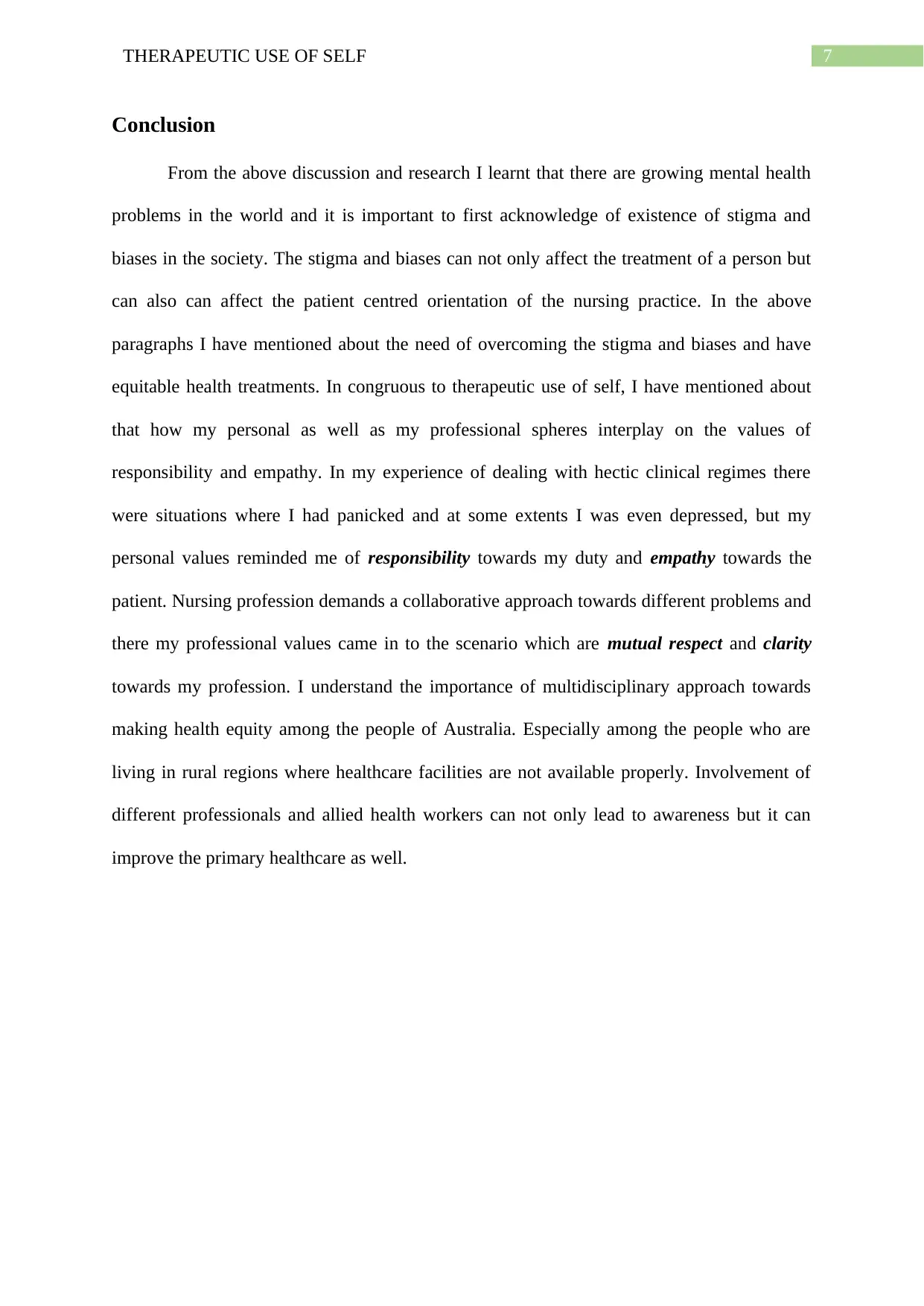
7THERAPEUTIC USE OF SELF
Conclusion
From the above discussion and research I learnt that there are growing mental health
problems in the world and it is important to first acknowledge of existence of stigma and
biases in the society. The stigma and biases can not only affect the treatment of a person but
can also can affect the patient centred orientation of the nursing practice. In the above
paragraphs I have mentioned about the need of overcoming the stigma and biases and have
equitable health treatments. In congruous to therapeutic use of self, I have mentioned about
that how my personal as well as my professional spheres interplay on the values of
responsibility and empathy. In my experience of dealing with hectic clinical regimes there
were situations where I had panicked and at some extents I was even depressed, but my
personal values reminded me of responsibility towards my duty and empathy towards the
patient. Nursing profession demands a collaborative approach towards different problems and
there my professional values came in to the scenario which are mutual respect and clarity
towards my profession. I understand the importance of multidisciplinary approach towards
making health equity among the people of Australia. Especially among the people who are
living in rural regions where healthcare facilities are not available properly. Involvement of
different professionals and allied health workers can not only lead to awareness but it can
improve the primary healthcare as well.
Conclusion
From the above discussion and research I learnt that there are growing mental health
problems in the world and it is important to first acknowledge of existence of stigma and
biases in the society. The stigma and biases can not only affect the treatment of a person but
can also can affect the patient centred orientation of the nursing practice. In the above
paragraphs I have mentioned about the need of overcoming the stigma and biases and have
equitable health treatments. In congruous to therapeutic use of self, I have mentioned about
that how my personal as well as my professional spheres interplay on the values of
responsibility and empathy. In my experience of dealing with hectic clinical regimes there
were situations where I had panicked and at some extents I was even depressed, but my
personal values reminded me of responsibility towards my duty and empathy towards the
patient. Nursing profession demands a collaborative approach towards different problems and
there my professional values came in to the scenario which are mutual respect and clarity
towards my profession. I understand the importance of multidisciplinary approach towards
making health equity among the people of Australia. Especially among the people who are
living in rural regions where healthcare facilities are not available properly. Involvement of
different professionals and allied health workers can not only lead to awareness but it can
improve the primary healthcare as well.
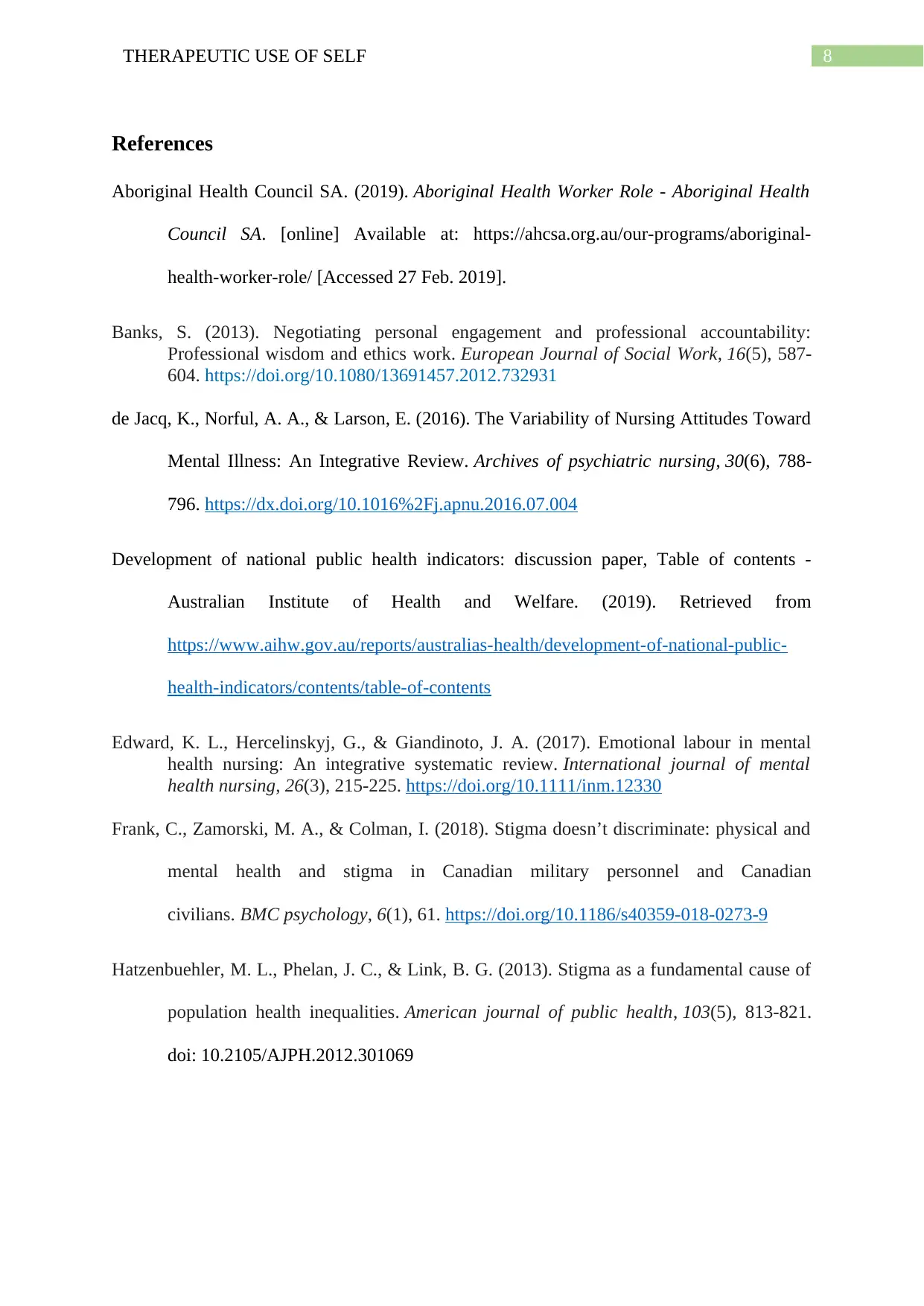
8THERAPEUTIC USE OF SELF
References
Aboriginal Health Council SA. (2019). Aboriginal Health Worker Role - Aboriginal Health
Council SA. [online] Available at: https://ahcsa.org.au/our-programs/aboriginal-
health-worker-role/ [Accessed 27 Feb. 2019].
Banks, S. (2013). Negotiating personal engagement and professional accountability:
Professional wisdom and ethics work. European Journal of Social Work, 16(5), 587-
604. https://doi.org/10.1080/13691457.2012.732931
de Jacq, K., Norful, A. A., & Larson, E. (2016). The Variability of Nursing Attitudes Toward
Mental Illness: An Integrative Review. Archives of psychiatric nursing, 30(6), 788-
796. https://dx.doi.org/10.1016%2Fj.apnu.2016.07.004
Development of national public health indicators: discussion paper, Table of contents -
Australian Institute of Health and Welfare. (2019). Retrieved from
https://www.aihw.gov.au/reports/australias-health/development-of-national-public-
health-indicators/contents/table-of-contents
Edward, K. L., Hercelinskyj, G., & Giandinoto, J. A. (2017). Emotional labour in mental
health nursing: An integrative systematic review. International journal of mental
health nursing, 26(3), 215-225. https://doi.org/10.1111/inm.12330
Frank, C., Zamorski, M. A., & Colman, I. (2018). Stigma doesn’t discriminate: physical and
mental health and stigma in Canadian military personnel and Canadian
civilians. BMC psychology, 6(1), 61. https://doi.org/10.1186/s40359-018-0273-9
Hatzenbuehler, M. L., Phelan, J. C., & Link, B. G. (2013). Stigma as a fundamental cause of
population health inequalities. American journal of public health, 103(5), 813-821.
doi: 10.2105/AJPH.2012.301069
References
Aboriginal Health Council SA. (2019). Aboriginal Health Worker Role - Aboriginal Health
Council SA. [online] Available at: https://ahcsa.org.au/our-programs/aboriginal-
health-worker-role/ [Accessed 27 Feb. 2019].
Banks, S. (2013). Negotiating personal engagement and professional accountability:
Professional wisdom and ethics work. European Journal of Social Work, 16(5), 587-
604. https://doi.org/10.1080/13691457.2012.732931
de Jacq, K., Norful, A. A., & Larson, E. (2016). The Variability of Nursing Attitudes Toward
Mental Illness: An Integrative Review. Archives of psychiatric nursing, 30(6), 788-
796. https://dx.doi.org/10.1016%2Fj.apnu.2016.07.004
Development of national public health indicators: discussion paper, Table of contents -
Australian Institute of Health and Welfare. (2019). Retrieved from
https://www.aihw.gov.au/reports/australias-health/development-of-national-public-
health-indicators/contents/table-of-contents
Edward, K. L., Hercelinskyj, G., & Giandinoto, J. A. (2017). Emotional labour in mental
health nursing: An integrative systematic review. International journal of mental
health nursing, 26(3), 215-225. https://doi.org/10.1111/inm.12330
Frank, C., Zamorski, M. A., & Colman, I. (2018). Stigma doesn’t discriminate: physical and
mental health and stigma in Canadian military personnel and Canadian
civilians. BMC psychology, 6(1), 61. https://doi.org/10.1186/s40359-018-0273-9
Hatzenbuehler, M. L., Phelan, J. C., & Link, B. G. (2013). Stigma as a fundamental cause of
population health inequalities. American journal of public health, 103(5), 813-821.
doi: 10.2105/AJPH.2012.301069
⊘ This is a preview!⊘
Do you want full access?
Subscribe today to unlock all pages.

Trusted by 1+ million students worldwide
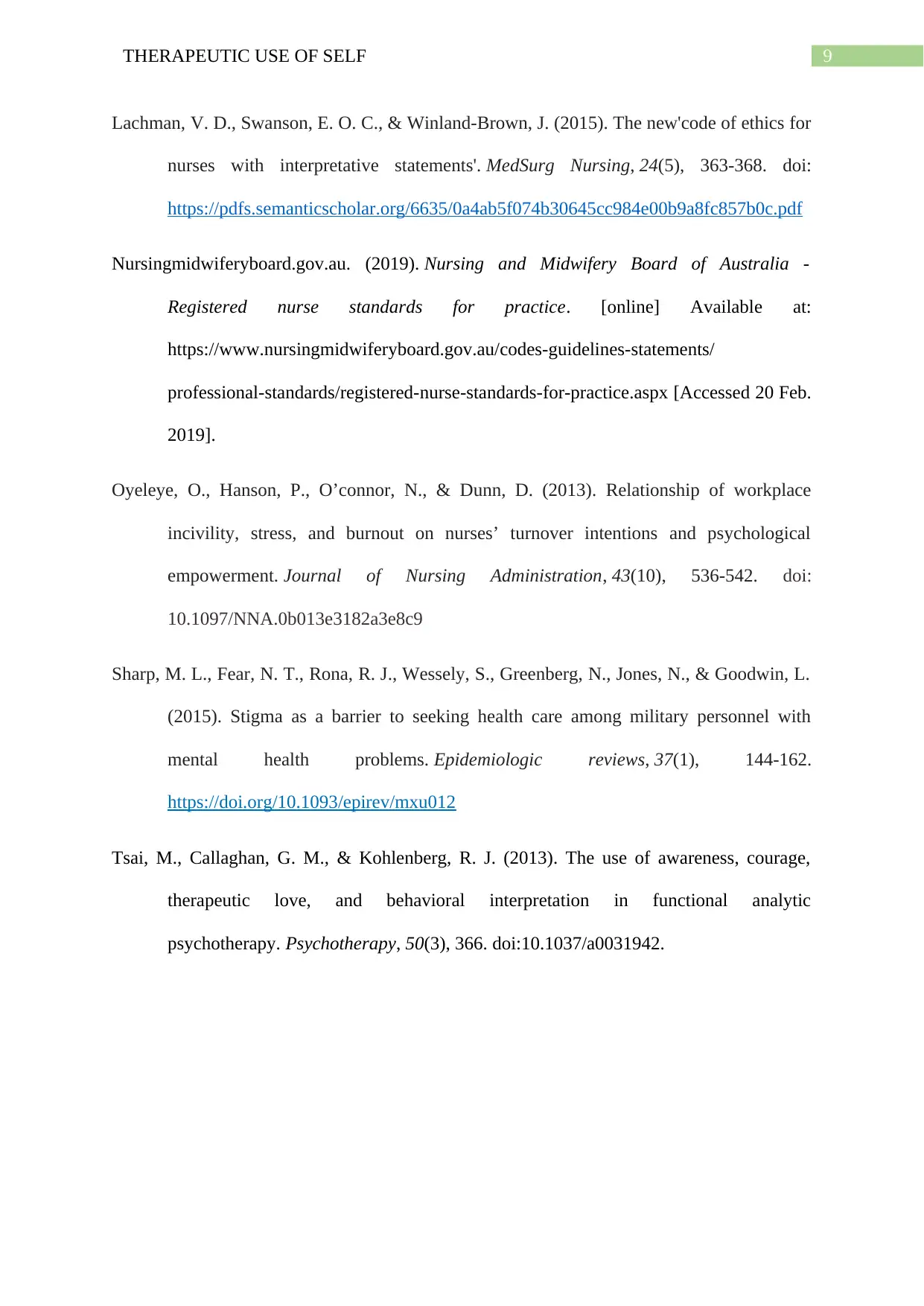
9THERAPEUTIC USE OF SELF
Lachman, V. D., Swanson, E. O. C., & Winland-Brown, J. (2015). The new'code of ethics for
nurses with interpretative statements'. MedSurg Nursing, 24(5), 363-368. doi:
https://pdfs.semanticscholar.org/6635/0a4ab5f074b30645cc984e00b9a8fc857b0c.pdf
Nursingmidwiferyboard.gov.au. (2019). Nursing and Midwifery Board of Australia -
Registered nurse standards for practice. [online] Available at:
https://www.nursingmidwiferyboard.gov.au/codes-guidelines-statements/
professional-standards/registered-nurse-standards-for-practice.aspx [Accessed 20 Feb.
2019].
Oyeleye, O., Hanson, P., O’connor, N., & Dunn, D. (2013). Relationship of workplace
incivility, stress, and burnout on nurses’ turnover intentions and psychological
empowerment. Journal of Nursing Administration, 43(10), 536-542. doi:
10.1097/NNA.0b013e3182a3e8c9
Sharp, M. L., Fear, N. T., Rona, R. J., Wessely, S., Greenberg, N., Jones, N., & Goodwin, L.
(2015). Stigma as a barrier to seeking health care among military personnel with
mental health problems. Epidemiologic reviews, 37(1), 144-162.
https://doi.org/10.1093/epirev/mxu012
Tsai, M., Callaghan, G. M., & Kohlenberg, R. J. (2013). The use of awareness, courage,
therapeutic love, and behavioral interpretation in functional analytic
psychotherapy. Psychotherapy, 50(3), 366. doi:10.1037/a0031942.
Lachman, V. D., Swanson, E. O. C., & Winland-Brown, J. (2015). The new'code of ethics for
nurses with interpretative statements'. MedSurg Nursing, 24(5), 363-368. doi:
https://pdfs.semanticscholar.org/6635/0a4ab5f074b30645cc984e00b9a8fc857b0c.pdf
Nursingmidwiferyboard.gov.au. (2019). Nursing and Midwifery Board of Australia -
Registered nurse standards for practice. [online] Available at:
https://www.nursingmidwiferyboard.gov.au/codes-guidelines-statements/
professional-standards/registered-nurse-standards-for-practice.aspx [Accessed 20 Feb.
2019].
Oyeleye, O., Hanson, P., O’connor, N., & Dunn, D. (2013). Relationship of workplace
incivility, stress, and burnout on nurses’ turnover intentions and psychological
empowerment. Journal of Nursing Administration, 43(10), 536-542. doi:
10.1097/NNA.0b013e3182a3e8c9
Sharp, M. L., Fear, N. T., Rona, R. J., Wessely, S., Greenberg, N., Jones, N., & Goodwin, L.
(2015). Stigma as a barrier to seeking health care among military personnel with
mental health problems. Epidemiologic reviews, 37(1), 144-162.
https://doi.org/10.1093/epirev/mxu012
Tsai, M., Callaghan, G. M., & Kohlenberg, R. J. (2013). The use of awareness, courage,
therapeutic love, and behavioral interpretation in functional analytic
psychotherapy. Psychotherapy, 50(3), 366. doi:10.1037/a0031942.
1 out of 10
Related Documents
Your All-in-One AI-Powered Toolkit for Academic Success.
+13062052269
info@desklib.com
Available 24*7 on WhatsApp / Email
![[object Object]](/_next/static/media/star-bottom.7253800d.svg)
Unlock your academic potential
Copyright © 2020–2025 A2Z Services. All Rights Reserved. Developed and managed by ZUCOL.





